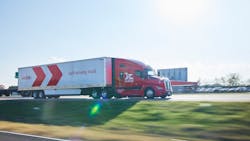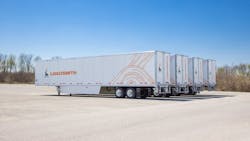How Loadsmith plans to use autonomous trucks to boost driver jobs and cut emissions
Later this summer, Loadsmith will launch its capacity-as-a-service model that founder and chief executive Brett Suma said is going to change how trucking operates—by not only providing more steady and regional work for drivers and small fleets but also relying on autonomous trucking to help decarbonize some of the busiest freight lanes in the U.S.
The freight startup, which offers brokerage services for shippers and carriers, has spent the past few years laying the groundwork for its high-tech logistics services. "We never started Loadsmith with the ambition of being the next big great freight brokerage," Suma told FleetOwner. "We started Loadsmith with the intention of really building and transforming the future of work for drivers."
He said the way trucking is designed now is that the drivers willing to make the most sacrifices, such as being away from home for weeks, get paid the most; however, local driving jobs, which can offer a better work-life balance, tend to pay less.
See also: Visiting these fleets is like being a kid in a candy storeSuma said that Loadsmith would change that with hundreds of self-driving tractor-trailers from Kodiak Robotics. "This might not make a lot of sense because we're talking about autonomous trucking, but we are a pro-driver organization from top to bottom," he said. "What we want to do is deploy middle-mile autonomous trucks to be the force-multiplication of really high-quality, high-paying first- and last-mile jobs. We're trying to change the paradigm that the highest-paid drivers are the ones who are willing to sacrifice the most, and the lowest-paid drivers are the ones that have, quote-unquote, the best jobs."
Suma said that pairing his company's technology with Kodiak Driver trucks will allow Loadsmith to better understand the consistent costs of autonomous middle miles while creating more demand for first- and last-mile hauling. "While some trucking companies are going out and raising driver pay for over-the-road trucking, we believe that we're going to be amongst the highest payers for local jobs because we're creating demand for a job that is over-supplied currently."
Those higher-paying local jobs will come with multiyear contracts with small fleets and independent drivers to handle the regional freight. And Suma said that Loadsmith could make the economics work by simply just focusing on the 150 most used freight lanes in the U.S. "We're not trying to solve for that load from Albuquerque, New Mexico, to Billings, Montana, as an example," he noted. "But there are 150 lanes in the U.S. that are super dense. They have consistent freight from all the major companies that move freight. Let's go build the Loadsmith freight network around those large, dense lanes."
On Aug. 1, Loadsmith will launch its new tech stack that Suma said would allow it to optimize freight movement along those 150 main lanes. It has already started on major lanes, such as Denver to Los Angeles.
"Loadsmith is the first trucking company built specifically for autonomous trucks, and we are proud that they selected Kodiak as the backbone of their operations," said Don Burnette, founder and CEO of Kodiak Robotics. "Loadsmith's founder Brett Suma is one of trucking's true visionaries, and now he is using his deep and unique experience to rethink logistics for the autonomous era."
Q&A: Loadsmith's 'first-mover advantage'
The following is an edited Q&A with Suma about his vision for Loadsmith and how he sees it helping decarbonize freight movement in the U.S. and benefiting smaller fleets nationwide.
FleetOwner: You just announced a deal to buy 800 autonomous trucks from Kodiak. While other fleets have been making deals to add self-driving technology to their operations, these would be Loadsmith's first trucks of any kind. Why are you taking this approach?
Suma: We have a first-mover advantage because we're purpose-building the world's first fully autonomous trucking company instead of retrofitting our current network. So we will go build for deployment instead of taking retrofitting trucks.
Our job currently is to build the ability—from a Loadsmith freight network perspective—to have the scale to deploy the truck. Second, we've got to build the technology that optimizes all the loads.
FO: How will the autonomous technology fit in with local human-driven trucks?
Suma: If you think of every load that we ship, we're going to have to break it into three different pieces: first mile, middle mile, and last mile. Unless you're pairing a last-mile delivery with a first-mile pickup, the unit economics won't work. We're going to have to build that optimization that breaks every load into these three pieces—and we're going to be putting it back together in three different pieces paired with two other levels. So there's a lot of optimization we'll have to build into our platform. We've got to continue to build density, and we've got to continue to distribute trailer pools.
We have to build all this optimization while Don and his Kodiak team have to work on building a viable safety driver that they can deliver to us by 2025. That is when we're saying we will be driver-out in the second half of 2025.
FO: California's state assembly recently passed a Teamster-supported bill banning humanless trucks from its roadways. Some of the most significant freight lanes start and end in Ontario, California, for example. How can you create your network without the Golden State?
Suma: California will get there eventually. I'm very confident in California. I think their regulatory hurdle will be quickly overcome as soon as somebody can adequately articulate how they can decarbonize the Ontario-to-Stockton lane, the densest lane in all of the United States. It's the largest lane from a greenhouse emissions perspective in the U.S. that can only be decarbonized through autonomous because the economics of it won't work if you don't.
FO: How does autonomous trucking cut down on emissions?
Suma: It's a combination of the efficiency of the truck and the utilization of the truck. Because I can utilize that truck 2.5 times that of a conventional truck. It's also the predictability that will be needed to drive utilization. Just because you can use the truck 2.5 times more doesn't mean you will if you don't have the freight network to support it and all the other ancillary stuff of optimizing the first and last miles. So you have to build the entire thing.
See also: Kodiak turns Class 8 EV into self-driving truck
Then you just have to build one truck port in Ontario and one truck port in Stockton for EV charging and hydrogen fueling instead of trying to solve the problem everywhere. That's all you have to do.
If California wants to be a leader in decarbonization, the path forward for them is there, but it has to be autonomous to do it. They have to get on board, and the path to get them there is through decarbonization efforts.
FO: Locksmith plans to deploy 6,000 trailers on its freight network driven by autonomous trucks on the middle mile. But how will you handle the first and last miles of the network, which still need human drivers?
Suma: We will contract with smaller fleets. I would love nothing more than to have an independent owner-operator come to me and say, 'I'd like to have a three-year contract with you to work locally in Phoenix,' or 'I have five trucks, and my drivers want to come off the road. How can we partner and build a local fleet of independent and small carriers to provide more local driving jobs?'
I would love to have those conversations. Those people do really great work. And we want to be viewed as very pro-driver and very small fleet-centric. As a company, that gives opportunities to fleets that probably never would have had the opportunity otherwise.
FO: Many small fleets and owner-operators might feel that technology, such as autonomous and electrification, is making it harder for them to thrive in this industry. What's your message to those smaller businesses?
We love them. None of this works without them. The biggest thing that people need to realize is that autonomous is great. It's incredible technology. It will provide a lot of elasticity and stability in the supply chain. But it's also great that we can build the future of work for these great men and women that do this job of driving.
About the Author
Josh Fisher
Editor-in-Chief
Editor-in-Chief Josh Fisher has been with FleetOwner since 2017. He covers everything from modern fleet management to operational efficiency, artificial intelligence, autonomous trucking, alternative fuels and powertrains, regulations, and emerging transportation technology. Based in Maryland, he writes the Lane Shift Ahead column about the changing North American transportation landscape.


